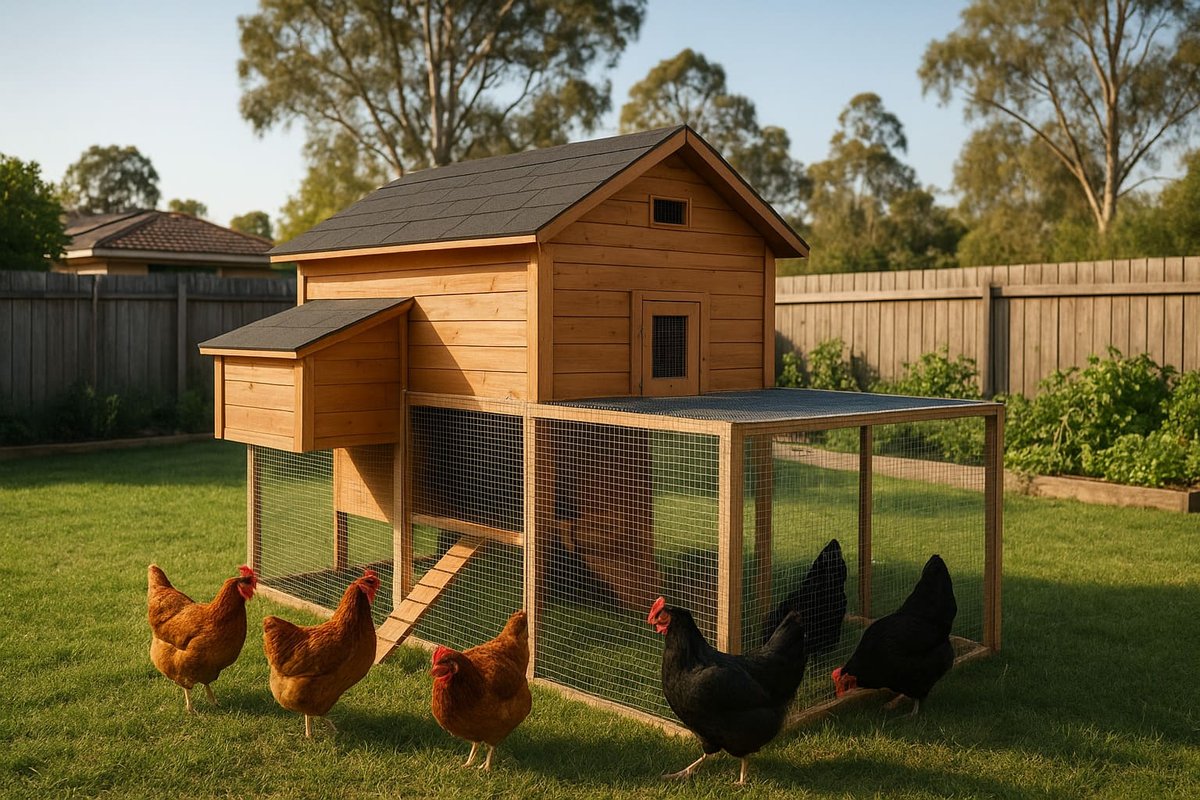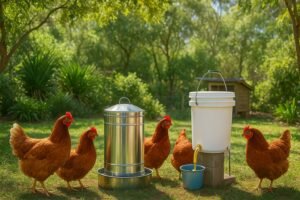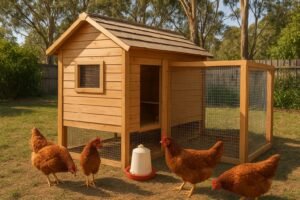Yes, you can legally keep backyard chickens (or “chooks,” as we often call them) across all Australian states and territories, but the specific rules vary dramatically depending on where you live. Most metropolitan councils allow between 4-10 chickens without a permit, while rural properties typically permit 20 or more birds. However, navigating the maze of state legislation, council by-laws, and the new national animal welfare standards can feel overwhelming for new chicken keepers.
Whether you’re in Queensland considering your first flock, wondering about NSW egg-selling regulations, or trying to understand Victoria’s upcoming early 2026 welfare requirements, this comprehensive guide breaks down exactly what’s legal in your area. We’ll cover everything from how many chickens you can keep in each state to coop placement rules, rooster restrictions, and the national welfare standards that came into effect six months ago (July 1, 2025).
Can I Keep Chickens in My Backyard in Australia?
Absolutely. Keeping backyard chickens in Australia is a popular and fast-growing hobby. But the simple “yes” comes with a big “but”: it all depends on your local council’s rules.
While all states permit chickens, there’s no single set of “Australian” rules. Instead, each state sets broad animal welfare laws, and then your local council (e.g., City of Yarra, Brisbane City Council) creates specific by-laws on top of that. This is why your neighbour in a different council area might be able to keep 10 chickens while you’re limited to 5.
Here’s the general lay of the land:
- Metropolitan (Metro) Areas: Most suburban blocks in cities like Sydney, Melbourne, and Brisbane are allowed to keep a small flock, usually 5-10 hens.
- Rural/Acreage Areas: If you’re on a larger block, your allowance will be much higher, often 20 or more, but you might need a Property Identification Code (PIC).
- Roosters: Forget it. Almost every single metropolitan council bans roosters in residential areas due to noise.
- New Standards: The biggest change is the new national animal welfare standards, which commenced on July 1, 2025. These apply to everyone, not just commercial farms, and set new minimums for things like perches, nests, and scratch areas in your coop.
Why Are So Many Aussies Getting Chickens?
This “chook-boom” isn’t just your imagination. This trend was supercharged by the 2024 egg shortages, which saw supermarket shelves empty due to factors like bird flu outbreaks and the industry’s big shift away from caged eggs. With rising egg prices, a desire for sustainable living, and a great way to teach kids where food comes from, backyard chickens have become the perfect addition to the Aussie backyard. They’re a pet with benefits: fresh eggs, amazing garden fertiliser, and fantastic pest control.
After researching all the state regulations, the key takeaway is this: your local council’s website is the ultimate source of truth. But don’t worry, we’ve done the heavy lifting to give you a clear starting point.
Now that you know the ‘why’, let’s look at the ‘how many’. This quick-reference table breaks down the typical rules, but remember, your local council has the final say.
Important: These are typical ranges based on common council regulations. Your specific council may have different rules. Always verify with your local council before purchasing chickens.
Quick Reference Guide – Chickens Allowed by State (2025)
This table gives you a quick, scannable overview of typical rules in residential areas. Always double-check these figures with your local council, as they can (and do) change.
| State | Typical Residential Limit | Rural Limit | Roosters Allowed? (Residential) | Permit Usually Required? |
|---|---|---|---|---|
| Queensland | 6 chickens (on blocks <800m²) | 20 chickens (on blocks >800m²) | No | Yes (e.g., Brisbane City) |
| New South Wales | 5-10 chickens (varies) | Varies by council | No | Varies by council |
| Victoria | 5-12 chickens (varies) | Varies by council | Generally no | Not for under 50 birds |
| South Australia | 4-5 chickens (or nuisance-based) | Varies | Not recommended | Varies by council |
| Western Australia | Up to 12 birds | Varies | Prohibited | Varies (e.g., Perth City needs plans) |
| Northern Territory | No specific limits | No specific limits | No restrictions (but nuisance rules apply) | PIC req’s must be verified |
| Tasmania | No specific limits (nuisance-based) | Varies | Permission from neighbours required | No (but must follow setbacks) |
| ACT | No specific limits (welfare-based) | N/A | Discouraged (nuisance rules apply) | No (but must follow Code of Practice) |
These numbers give you a great starting point, but the real details—like coop placement and setbacks—are in the state-by-state breakdown. Let’s dive in.
Detailed State-by-State Breakdown
Let’s dig into the specifics for every state and territory. We’ll use major council areas as examples to give you a practical idea of what to expect.
Queensland: Can I Have Chickens in My Backyard in QLD?
If you’re asking, “Can I have chickens in my backyard in QLD?”, the answer is a firm “yes,” but rules can differ even between neighbouring councils.
Brisbane City Council (BCC) Example: (Source: Brisbane City Council’s poultry keeping requirements)
- Property Size Matters:
- Under 800m²: You can keep a maximum of 6 chickens.
- Over 800m²: You can keep up to 20 chickens.
- Permits: Yes, you need one. Brisbane City Council requires all domestic chicken keepers to apply for a free permit.
- Roosters: Not a chance. Roosters are not permitted in residential areas.
- Coop Placement: Must be at least 1 metre from any dividing fence.
- Maintenance: The coop must be kept clean, and feed stored in pest-proof containers.
Gold Coast City Council (GCCC) Example: The Gold Coast is similar but has its own specific setback rules for how far a coop must be from a residence, which can be significant. This setback rule is a big factor in planning, so check the GCCC website for the exact distance.
- Roosters: Only allowed on properties over 4,000m² (one acre).
New South Wales: Rules and Egg-Selling Regulations
NSW is generally quite generous, but coop placement is the key.
North Sydney Council Example (Typical Metro): (Source: North Sydney Council’s chicken keeping regulations)
- Maximum Flock: 10 chickens.
- Roosters: Absolutely no roosters in residential zones.
- Coop Specifications: This is where NSW gets detailed. Councils often have very specific rules for coop size (e.g., max 15m²), height, and materials (like requiring concrete floors for easy cleaning). Always check your specific council’s Development Control Plan (DCP) for these exact requirements.
Lithgow City Council Example (Exempt Development): This shows how rules can change based on your property’s zoning. Rural-zoned properties (like R5) typically allow more birds than standard residential zones. Check your council’s zoning map and local laws to confirm.
Can I Sell Eggs From My Backyard Chickens in NSW? Yes, but you must follow specific rules. Unlike the vague guidelines in other states, NSW has a clear system for small-scale producers.
- Notification is Mandatory: If you produce fewer than 20 dozen (240) eggs per week, you are not required to get a license, but you must notify the NSW Food Authority of your operation.
- Egg Stamping: All eggs sold in NSW must be individually stamped with a unique identifier.
- The Stamp: Once you notify the NSW Food Authority, they will supply you with a free one-off hand stamp with your pre-assigned code.
- The Exemption: You are exempt from stamping only if you sell direct from the farm gate (i.e., your house) or if the eggs are for a fundraising event where they will be cooked.
Beyond council compliance, it’s wise to understand the legal requirements for selling backyard eggs including food safety standards.
Victoria: Upcoming 2026 Welfare Requirements
Victoria has a fascinating mix of council rules, from very restrictive to quite permissive.
City of Yarra (Melbourne) Example:
- Maximum Flock: Often around 5 chickens, but this varies.
- Flats and units are generally not permitted to keep chickens.
- Coop Placement: Councils specify minimum distances from property fences, so check their local law.
City of Greater Geelong Example:
- Maximum Flock: Some councils, like Geelong, may be more permissive and allow a higher number of poultry based on your land size.
- Flats and units: 0 poultry allowed.
- Roosters: Not permitted on land under 4,000m².
Critical 2026 Update: New Welfare Standards This is the most important change for Victorian chicken keepers in decades. Victoria is implementing the new Australian Animal Welfare Standards and Guidelines for Poultry from upcoming early 2026. (Source: Victoria’s early 2026 implementation of poultry welfare standards). These rules affect all chicken keepers. We’ll cover what these standards mean for your coop in a dedicated section below.
South Australia: Nuisance vs. Numbers
SA councils often focus more on nuisance (smell, noise, pests) than a hard-and-fast number. For example, some councils may not set a specific limit but will investigate any formal complaint. Others may recommend a small number (like 4-5) for residential blocks and have strict setback rules for coops. Always check your local council’s specific by-laws.
Western Australia: Generous Numbers, Strict Placement
(Source: WA’s Animal Welfare (Poultry) Regulations 2024) WA is often generous with flock size, sometimes allowing up to 12 birds. However, councils in Perth can have some of the strictest placement rules, requiring significant setbacks from dwellings or even a written application with plans. Check with your council.
Northern Territory: The PIC is Key
(Source: NT Government’s poultry keeping guidelines) The NT has the simplest rules but one very important requirement.
- Property Identification Code (PIC): The NT has a unique requirement for a Property Identification Code (PIC). It’s widely reported this may apply to all poultry keepers, regardless of flock size. You must verify this specific requirement with the NT government before purchasing birds.
- Numbers: No specific limits, but you must follow national welfare standards and not cause a nuisance.
Tasmania: The “Neighbour-Permission” Model
Tasmania puts a heavy emphasis on not bothering your neighbours.
- Hobart City Council:
- Numbers: No specific limit.
- Setbacks: Councils like Hobart have specific rules for how far a coop must be from dwellings and boundaries.
- Roosters: The rules for roosters can be extremely strict, with some councils requiring written permission from all neighbours within a large radius. This is a very high bar to clear.
- Launceston City Council: Focuses on nuisance. Roaming, smell, and noise are the main issues.
Australian Capital Territory (ACT): The Welfare Model
The ACT doesn’t set numbers. Instead, it just requires you to follow the law, which is the “Animal Welfare (Welfare of Poultry: Non-Commercial) Code of Practice 2010.” (It’s important to verify this is still the most current Code of Practice).
- The Rules: This code states you must provide:
- Adequate food, water, and shelter.
- Freedom to move and express normal behaviours.
- Social contact (i.e., don’t keep one chicken on its own).
- Roosters: Are strongly discouraged, as they will almost certainly cause a noise nuisance, which is a breach of the rules.
Phew. That’s a lot of different rules. But you’ll notice one thing they all have in common: the new 2025-2026 welfare standards. Let’s break down what you actually need to do.
Understanding the New 2025 National Welfare Standards
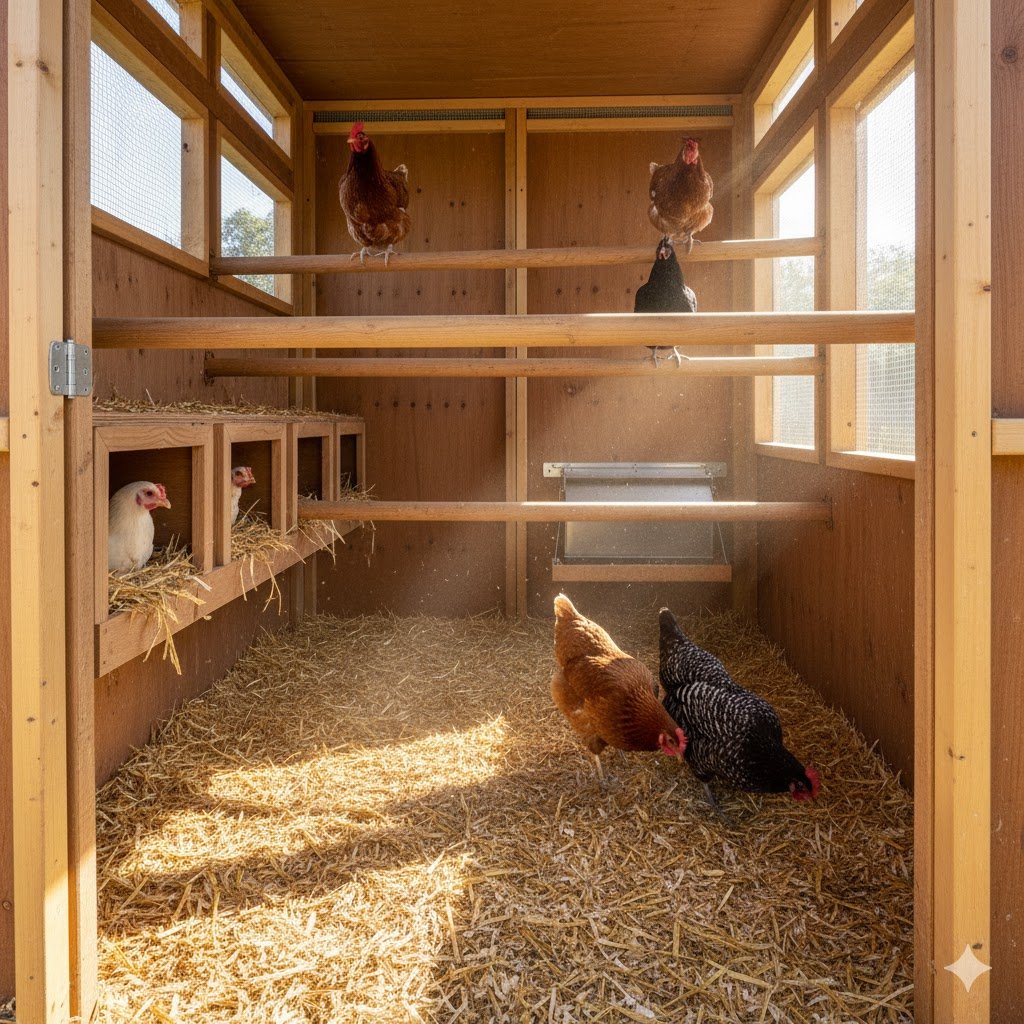
This is the new rulebook for all of Australia, and it’s a big deal. The Australian Animal Welfare Standards and Guidelines for Poultry are being rolled out state by state. The core standards commenced on July 1, 2025, with states like WA being first to implement (see WA’s Animal Welfare (Poultry) Regulations 2024) and others like Victoria implementing their specific requirements in upcoming early 2026 (see Victoria’s early 2026 implementation). These standards apply to BOTH commercial farms and us backyard owners.
Here are the key changes and what they mean for your coop.
A Practical Checklist: What Do I Actually Need to Buy or Build?
The new rules are all about letting chickens be chickens. Your compliant coop must have:
- Perches: All chickens must have access to perches to roost on at night (not just a flat floor). These should be round or oval, at least 3-4cm wide, and not made of sharp-edged metal.
- Nest Boxes: You must provide clean, private, and dark nest boxes for hens to lay their eggs. A good rule of thumb is one nest box for every 3-4 hens.
- Substrate Area: Your chickens must have access to a “scratch area” with loose material (litter) like straw, sawdust, or soil for them to peck, scratch, and “dust bathe” in.
New Standards for Outdoor & Free-Range Setups
If you plan to let your chickens roam in a run or free-range in your yard, the new standards set clear rules to ensure their welfare:
- Feathering: Birds must be “adequately feathered” before they are allowed outdoor access (this mainly applies to young chicks, protecting them from the elements).
- Shelter: Your flock must have “ready access to housing and shaded areas” to protect them from sun, rain, and predators.
- Access Points: You must provide a “reasonable number and size of access points” to the coop, ensuring birds don’t get ‘trapped’ outside or crowded trying to get in.
Humane Practice Standards (Beak Trimming)
The new standards also formalise humane practices, which are more relevant to commercial farms but good to know. For instance, “hot blade beak trimming must not be used,” except in very specific circumstances under veterinary advice. For backyard keepers, this reinforces that such modifications are not a standard or humane practice.
What ‘Substrate’ Means (and Why Your Chooks Need It)
“Substrate” is just a fancy word for the bedding on the floor of your coop and run. Chickens have a natural, powerful instinct to scratch in the dirt. It’s how they find food, clean themselves (dust bathing), and keep their minds busy.
Providing this isn’t hard. It’s what’s known as the Deep Litter Method, and it’s actually easier than cleaning your coop every week. The new substrate requirements are easily satisfied by setting up a proper dust bath that meets 2025 substrate requirements.
- How it works: Start with a 15cm+ layer of “brown” material like wood shavings, straw, or hemp bedding.
- Maintenance: Once a week, just turn the litter over with a pitchfork (like you’re fluffing a pillow) and add a fresh thin layer on top.
- The magic: Good microbes in the litter compost the manure in place, leaving you with no smell, happy chooks, and you only need to clean it out fully once or twice a year, leaving you with amazing compost.
Your ‘Contingency Plan’: What to Write Down for Emergencies
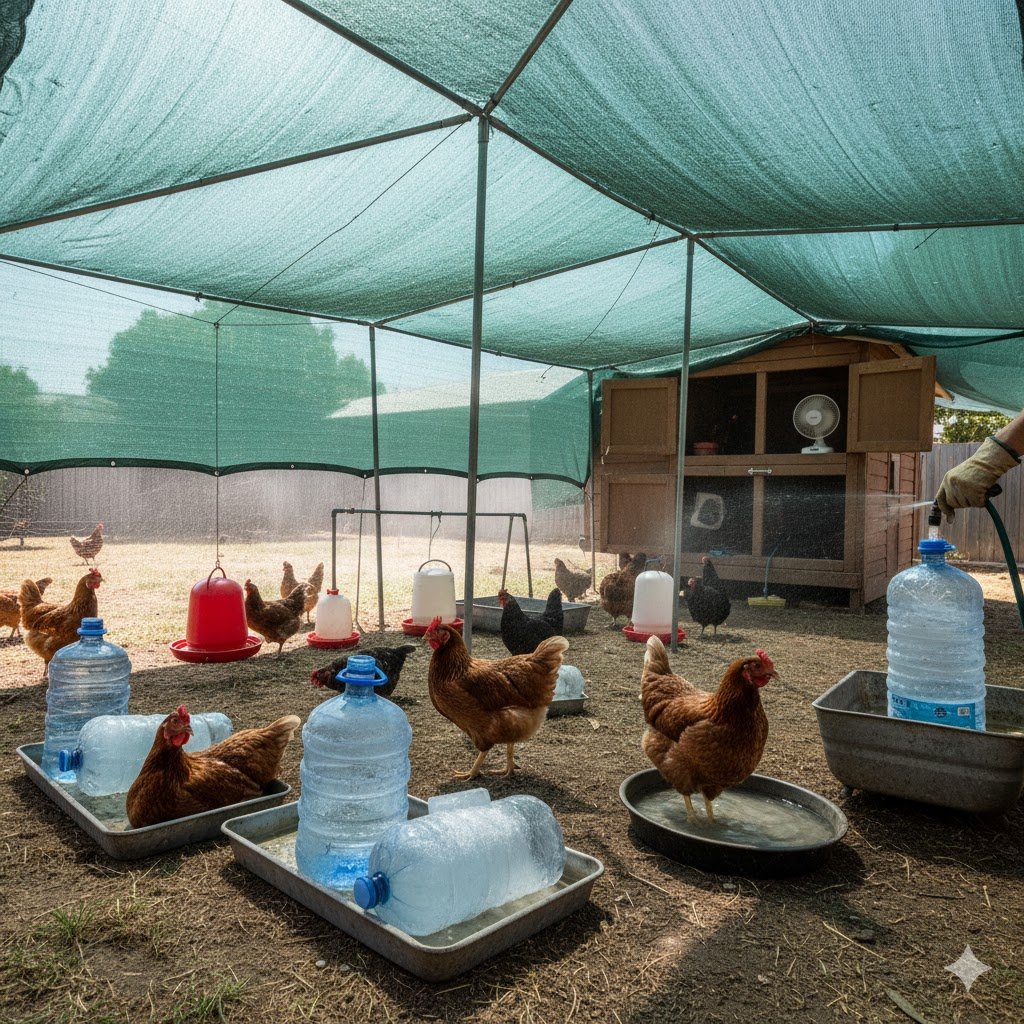
The new standards also require you to have a written plan for what to do in an emergency. This sounds scarier than it is. Just grab a piece of paper, write “Chicken Emergency Plan” on it, and stick it to your fridge.
It should include:
- Heatwave Plan (40°C+):
- Freeze 2L water bottles and place them in the coop.
- Set up extra shade (a cheap tarp is perfect). Implement these proven cooling strategies for Australian summers.
- Check and refill their water 3-4 times a day. Consider specialized waterers designed for Australian heat that prevent water from reaching dangerous temperatures.
- Disease/Sickness Plan:
- Phone number for an avian vet (find one before you need one).
- Have a spare cage/dog crate to use as a “quarantine” hospital pen.
- Fire Plan: Your written contingency plan should include bushfire preparedness protocols for properties in fire-prone areas.
- Holiday Plan:
- Name and phone number of the friend/neighbour who will be “chook-sitting.”
- Simple list of “feed, water, collect eggs, lock up at dusk.”
These standards are all about responsible ownership. And a big part of that is your coop. Let’s talk about building one that’s not just compliant, but a fortress.
Coop, Predators, and Pests: The Practical Essentials
Your chickens have two main jobs: lay eggs and try not to get eaten. Your job is to build a coop that helps with both.
Building a Predator-Proof Coop: Your Australian Guide

A “predator-proof” coop in Australia means something very different than it does overseas. Our predators are smart, strong, and persistent. Australia’s unique wildlife threats (foxes, goannas, snakes, quolls) demand specialized strategies. Our comprehensive Australian predator protection guide covers prevention methods for all major threats.
Australia’s Top Predators (and How to Beat Them)
- Foxes: The #1 killer. They can rip “chicken wire,” dig, and even climb.
- Goannas & Quolls: Can climb, squeeze through small gaps, and are very strong.
- Snakes (Pythons): Will take chicks, hens, and eggs. They can get through a 2cm gap.
- Hawks & Eagles: Will swoop an unwary chook in an open yard.
- Rats & Mice: Won’t (usually) kill a hen, but they will eat eggs, chicks, and tonnes of feed, attracting snakes in the process.
The ‘Fort Knox’ Coop Checklist
Your coop is only as strong as its weakest point. Use this checklist.
- Wire (The Most Important Part):
- Do NOT use “chicken wire” (the flimsy hexagon stuff). A fox can rip it with its teeth.
- DO use 10mm x 10mm (or 1/2 inch) galvanised “welded mesh” or “snake/rodent proof” wire. This is the only thing that stops snakes and rats. Follow these proven snake-proofing techniques.
- The Floor:
- Best: A solid concrete slab or paver floor. Nothing can dig through it.
- Good: Build a wire “skirt.” This means laying the 10x10mm mesh flat on the ground, extending 50cm outwards from the base of the coop, and pegging it down. When a fox tries to dig, it hits wire and gives up.
- Locks:
- Do NOT use simple twist latches. A fox or goanna can flip these.
- DO use two-step locks: A sliding bolt with a carabiner or padlock is perfect.
- The Roof:
- Your coop and run must have a solid or mesh roof to stop climbing predators and hawks.
- Design: The new welfare standards require predator protection. Implement snake-proof coop designs that meet both safety and legal requirements.
Managing Manure and Pests: The ‘Not-So-Fun’ Essentials
A clean coop is a healthy coop.
The ‘Deep Litter Method’: Less Cleaning, Better Coop
As we mentioned in the welfare section, this is the best way to manage manure and keep your chooks happy. It’s a win-win. By keeping a 15cm+ layer of dry carbon material (wood shavings, straw) and turning it weekly, you create a self-composting floor that is odour-free and full of healthy microbes.
Composting Chicken Manure: Turning ‘Hot’ Waste into ‘Black Gold’
When you do your big clean-out, you’ll have a pile of the world’s best fertiliser. But you can’t put it straight on your garden—it’s too “hot” (high in nitrogen) and will burn your plants.
- The Ratio: You need a 2:1 mix. Two parts “browns” (dried leaves, shredded paper, wood shavings) to one part “greens” (the chicken manure/litter).
- The Process: Layer it in a compost bin, add a little water, and turn it every couple of weeks.
- The Science: You want the pile to heat up to 60-70°C. This kills any bad bacteria.
- The Result: After 3-6 months, you’ll have rich, dark, beautiful compost that your veggie patch will love.
Now that your coop is sorted, it’s time for the fun part: choosing your birds.
Flock Health, Breeds, and Biosecurity
Keeping your flock healthy starts before you even buy them.
Which Chicken Breed is Right for My Backyard?

Not all chooks are created equal. Some are egg-laying machines, while others are quiet, cuddly pets. Here’s a quick guide.
| Breed | Egg Laying (per year) | Noise Level | Good with Kids? | Aussie Climate? |
|---|---|---|---|---|
| Isa Brown | 300 – 350+ | Low-Moderate | Generally | Good, but a shorter lifespan |
| Australorp | 250 – 300 | Very Quiet | Excellent | Excellent (Aussie breed!) |
| Orpington | 170 – 200 | Very Quiet | Excellent | Good, but fluff can get hot |
| Wyandotte | 200 – 240 | Moderate | Good | Very hardy for cold/hot |
| Silkie | 100 – 120 | Very Quiet | Excellent | Good, but feathers aren’t waterproof |
| Leghorn | 280 – 320+ | Loud | No (Flighty) | Very hardy |
| Araucana | 180 – 200 | Moderate | Varies | Good (Lays blue eggs!) |
The Bottom Line:
- For Maximum Eggs: Get Isa Browns.
- For a Quiet, Family Pet: Get Australorps or Orpingtons.
- For Coloured Eggs: Get an Araucana (blue eggs) or Marans (dark brown eggs).
New to chickens? Start with these beginner-friendly chicken breeds that handle Australian conditions well. For hot northern areas, consider choosing heat-tolerant breeds suited to your Australian climate.
Biosecurity: Protecting Your Flock (and Australia’s)

“Biosecurity” is a simple idea: stopping disease from getting in or out. For a backyarder, it means three things:
- Quarantine: When you get new chickens, you must keep them in a separate cage, far away from your old flock, for at least 30 days. This is to see if they get sick.
- Cleanliness & Wild Bird Prevention: This is now a critical legal requirement. You must “take reasonable actions to minimise access to poultry feed and drinking water by wild birds.” This is the #1 way to prevent Avian Influenza (Bird Flu). After the 2024 outbreaks, this is a non-negotiable part of chicken keeping. Don’t leave feed out in the open; use a treadle feeder or place it under cover where pigeons, mynas, and sparrows can’t get to it. Also, clean your boots if you’ve been to a friend’s chicken coop.
- Source: Buy your birds from a reputable hatchery. They will be vaccinated for key diseases like Marek’s.
Common Chicken Health Problems in Australia
Don’t panic! 99% of problems are caused by parasites and are easy to prevent.
- External Parasites (Mites & Lice):
- Signs: Scratching, feather loss, not wanting to go into the coop at night (red mites).
- Prevention: A good dust bathing area (with dirt and a sprinkle of Diatomaceous Earth). This is a dust bath setup that prevents parasites naturally while meeting legal requirements.
- Internal Parasites (Worms):
- Signs: Weight loss, diarrhoea.
- Prevention: A “wormer” from a pet store or vet, used every 6 months.
- Respiratory Issues:
- Signs: Sneezing, coughing, bubbly eyes (this is a bad sign).
- Action: Separate the sick bird immediately and call an avian vet.
- Marek’s Disease: A deadly virus with no cure.
- Prevention: This is why you must buy chicks vaccinated at the hatchery.
Feeling a bit overwhelmed? That’s normal. Let’s look at the other ‘realities’ of chicken keeping.
Special Considerations
This is the stuff people often forget to tell you.
The Realities: 10 Things to Consider Before You Buy
- The Daily Commitment: Chickens need care 365 days a year. Rain, hail, or shine, they need to be let out, fed, watered, and locked up safely at dusk.
- Unexpected Vet Costs: Avian vets are specialised and can be expensive. A sick chicken can easily lead to a significant vet bill.
- Predator Stress: The first time you see a fox or goanna near your run is terrifying. It requires constant vigilance.
- Holidays: You can’t just go away for a weekend. You need a reliable “chook-sitter” who knows what to do.
- Garden Damage: A free-ranging chicken will destroy your veggie patch and mulch in seconds. Fences are essential.
- The Pecking Order: Chickens aren’t always nice to each other. Introducing new birds can be a brutal process.
- Biosecurity: As we covered, you have a legal responsibility to help prevent the spread of poultry diseases.
- The End-of-Life: You will eventually have to deal with a sick or old bird. You must have a plan for humane euthanasia (which usually means a vet).
- The “Oops, it’s a Rooster”: Even from a hatchery, you’ll sometimes get a male chick by accident. You must have a plan for re-homing it, as you can’t keep it.
Can You Have Just One Backyard Chicken?
While it might be legally possible (no council specifies a minimum), it’s a bad welfare outcome. Chickens are highly social flock animals. A single, lonely chicken will be stressed, depressed, and more likely to get sick. The ACT Code of Practice specifically mentions “social contact” as a requirement. For more on this, see the RSPCA’s backyard chicken care guidelines. Minimum recommended: At least 3 chickens. This way, they have a social structure, and if one sadly passes away, you’re not left with a single, lonely bird.
Special Question: Can Landlords Deny Pets in QLD?
This is a tricky one. QLD has new-ish tenancy laws that make it harder for landlords to refuse pets. However, chickens are often classed as “livestock,” not “pets.” Reality check: You need explicit written permission from your landlord. You must prove the property is suitable and that you won’t be violating any body corporate rules. Don’t even think about it without getting it in writing first.
If you’ve read all this and you’re still excited, then you’re ready. Here’s your final roadmap.
Getting Started – Your Practical 8-Step Roadmap
Ready to go? Here’s your checklist. Before starting your flock, it’s wise to review these common mistakes Australian beginners make to avoid regulatory oversights and simple errors.

Step 1: Your Council Deep Dive (The Most Important Step)
This is Step 1, 2, and 3. Go to your council’s website. Don’t just read the webpage; download the Local Law PDF or Fact Sheet. Find the exact rules for:
- Maximum number of birds.
- If roosters are banned (they are).
- Setback distances (e.g., “X metres from boundary, Y metres from dwelling”).
- Coop size or permit requirements.
Step 2: Budgeting for Your Flock – The Real Costs
This is not a free hobby to start, but the ongoing costs are low. Prices vary significantly based on your state, breeder, and feed shop.
- Upfront Costs (Est. $500 – $1,500+):
- The Coop: Costs can range from cheap flat-packs (which often need predator-proofing) to more expensive, custom-built, or large pre-fab coops.
- The Birds: Budget for the cost of several point-of-lay hens. Prices vary by breeder and breed, but check local classifieds or hatchery websites for current 2025 pricing. For a comprehensive breakdown of startup costs for Australian chicken keepers, including coop, feed, and equipment, read our guide.
- The Gear: You’ll need a good quality feeder and waterer.
- First Setup: A bag of feed and a bale of bedding.
- Ongoing Costs:
- This includes regular bags of feed (check your local produce store for current prices), replacing bedding, and occasional worm or mite treatments.
- The Emergency Fund:
- Have an emergency fund set aside. A single vet visit can be costly, so it’s wise to be prepared.
Step 3: Notify Your Neighbours
Go over, knock on the door, and tell them your plan. “Hi, we’re thinking of getting 4 quiet hens, no roosters. Their coop will be over here, and we’ll keep it clean. Hope that’s okay! We’ll bring you some eggs.” This 5-minute chat can prevent 5 years of complaints.
Step 4: Build or Buy Your Compliant Coop
Now that you have your budget and your council rules, build or buy your coop. Before building, learn about strategic coop placement that meets council setback requirements to ensure compliance. Meeting the 2025 welfare standards while handling extreme heat requires coop designs specifically engineered for Australian heat.
Make sure it meets:
- Your council’s setback rules.
- The “Fort Knox” predator-proofing checklist.
- The 2025 welfare standards (perches, nests, substrate area).
Step 5: Set Up Your Biosecurity
Get your feeder/waterer, and make sure it’s placed where wild birds can’t easily access it. Have your “quarantine” cage ready, even if you’re getting all your birds at once (it’s good for a sick hen).
Step 6: Prepare for Arrival
Get the feed, waterer, and bedding before the chickens arrive. Set up the bedding (15cm deep!) in the coop. Have your “emergency plan” written down. Find your nearest avian vet’s phone number.
Step 7: Bringing Your Chickens Home
Transport them in a cat carrier or a cardboard box with holes. Put them straight into their secure coop/run with food and water. Don’t let them out to free-range for the first week—they need to learn that the coop is “home.” If you’re adding to an existing flock, you must do the 30-day quarantine.
Step 8: Implement Ongoing Compliance
Keep the coop clean (or just turn the deep litter), provide fresh food and water daily, and lock them up securely every single night at dusk. Enjoy the eggs!
This might seem like a lot, but it’s all part of responsible ownership. Let’s wrap this up.
Conclusion – Your Backyard Chicken Journey
Keeping backyard chickens in Australia is not only legal across all states but is an incredibly rewarding hobby. Whether you’re in Queensland navigating Brisbane’s permit system, New South Wales balancing the 10-chicken limit, or Victoria preparing for the upcoming early 2026 welfare standards, understanding your local regulations is the essential first step.
The national animal welfare standards, which commenced in July 2025 and are now in their first six months of enforcement, are a positive change, improving bird welfare and setting clear expectations for all of us. This isn’t just “red tape”—it’s a clear roadmap for how to keep your flock happy and healthy, which in turn means more (and better) eggs for you.
By following your council’s rules, being a good neighbour, building a predator-proof coop, and keeping your chooks safe and healthy, you’ll enjoy years of fresh eggs and the simple joy of watching them potter around your yard. Start small, stay compliant, and welcome to Australia’s thriving community of backyard chicken keepers.

Oladepo Babatunde is the founder of ChickenStarter.com. He is a backyard chicken keeper and educator who specializes in helping beginners raise healthy flocks, particularly in warm climates. His expertise comes from years of hands-on experience building coops, treating common chicken ailments, and solving flock management issues. His own happy hens are a testament to his methods, laying 25-30 eggs weekly.
